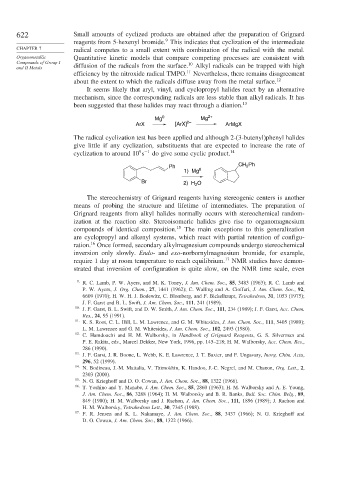Page 647 - Advanced Organic Chemistry Part B - Reactions & Synthesis
P. 647
622 Small amounts of cyclized products are obtained after the preparation of Grignard
9
reagents from 5-hexenyl bromide. This indicates that cyclization of the intermediate
CHAPTER 7 radical competes to a small extent with combination of the radical with the metal.
Organometallic Quantitative kinetic models that compare competing processes are consistent with
Compounds of Group I 10
and II Metals diffusion of the radicals from the surface. Alkyl radicals can be trapped with high
11
efficiency by the nitroxide radical TMPO. Nevertheless, there remains disagreement
about the extent to which the radicals diffuse away from the metal surface. 12
It seems likely that aryl, vinyl, and cyclopropyl halides react by an alternative
mechanism, since the corresponding radicals are less stable than alkyl radicals. It has
been suggested that these halides may react through a dianion. 13
Mg 0 Mg 2+
ArX [ArX] 2– ArMgX
The radical cyclization test has been applied and although 2-(3-butenyl)phenyl halides
give little if any cyclization, substituents that are expected to increase the rate of
9 −1
cyclization to around 10 s do give some cyclic product. 14
Ph CH Ph
2
1) Mg 0
Br 2) H O
2
The stereochemistry of Grignard reagents having stereogenic centers is another
means of probing the structure and lifetime of intermediates. The preparation of
Grignard reagents from alkyl halides normally occurs with stereochemical random-
ization at the reaction site. Stereoisomeric halides give rise to organomagnesium
compounds of identical composition. 15 The main exceptions to this generalization
are cyclopropyl and alkenyl systems, which react with partial retention of configu-
16
ration. Once formed, secondary alkylmagnesium compounds undergo stereochemical
inversion only slowly. Endo- and exo-norbornylmagnesium bromide, for example,
require 1 day at room temperature to reach equilibrium. 17 NMR studies have demon-
strated that inversion of configuration is quite slow, on the NMR time scale, even
9 R. C. Lamb, P. W. Ayers, and M. K. Toney, J. Am. Chem. Soc., 85, 3483 (1963); R. C. Lamb and
P. W. Ayers, J. Org. Chem., 27, 1441 (1962); C. Walling and A. Cioffari, J. Am. Chem. Soc., 92,
6609 (1970); H. W. H. J. Bodewitz, C. Blomberg, and F. Bickelhaupt, Tetrahedron, 31, 1053 (1975);
J. F. Garst and B. L. Swift, J. Am. Chem. Soc., 111, 241 (1989).
10
J. F. Garst, B. L. Swift, and D. W. Smith, J. Am. Chem. Soc., 111, 234 (1989); J. F. Garst, Acc. Chem.
Res., 24, 95 (1991).
11 K. S. Root, C. L. Hill, L. M. Lawrence, and G. M. Whitesides, J. Am. Chem. Soc., 111, 5405 (1989);
L. M. Lawrence and G. M. Whitesides, J. Am. Chem. Soc., 102, 2493 (1980).
12
C. Hamdouchi and H. M. Walborsky, in Handbook of Grignard Reagents, G. S. Silverman and
P. E. Rakita, eds., Marcel Dekker, New York, 1996, pp. 145–218; H. M. Walborsky, Acc. Chem. Res.,
286 (1990).
13 J. F. Garst, J. R. Boone, L. Webb, K. E. Lawrence, J. T. Baxter, and F. Ungavary, Inorg. Chim. Acta,
296, 52 (1999).
14
N. Bodineau, J.-M. Mattalia, V. Thimokhin, K. Handoo, J.-C. Negrel, and M. Chanon, Org. Lett., 2,
2303 (2000).
15
N. G. Krieghoff and D. O. Cowan, J. Am. Chem. Soc., 88, 1322 (1966).
16 T. Yoshino and Y. Manabe, J. Am. Chem. Soc., 85, 2860 (1963); H. M. Walborsky and A. E. Young,
J. Am. Chem. Soc., 86, 3288 (1964); H. M. Walborsky and B. R. Banks, Bull. Soc. Chim. Belg., 89,
849 (1980); H. M. Walborsky and J. Rachon, J. Am. Chem. Soc., 111, 1896 (1989); J. Rachon and
H. M. Walborsky, Tetrahedron Lett., 30, 7345 (1988).
17
F. R. Jensen and K. L. Nakamaye, J. Am. Chem. Soc., 88, 3437 (1966); N. G. Krieghoff and
D. O. Cowan, J. Am. Chem. Soc., 88, 1322 (1966).

